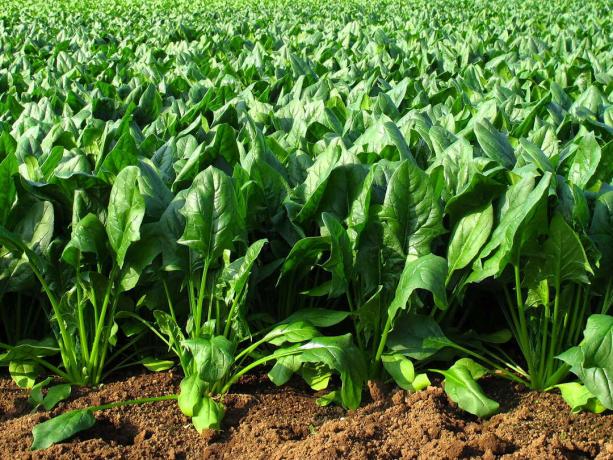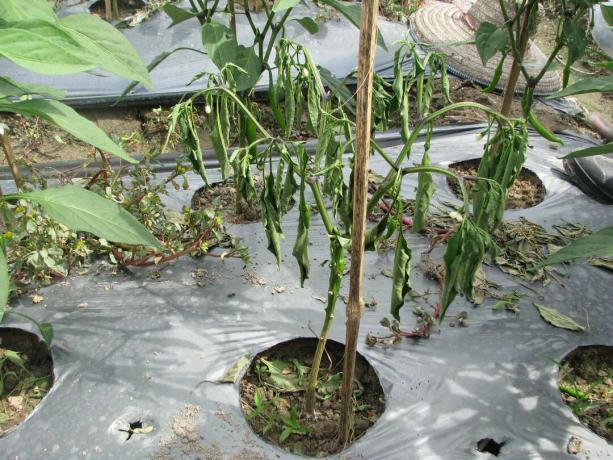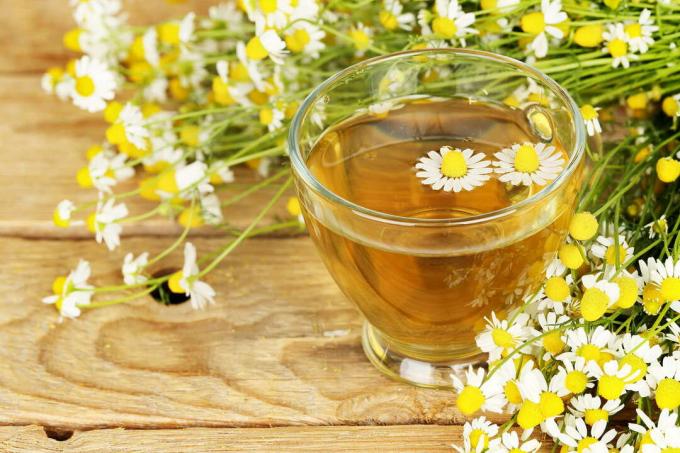Fusarium is a diverse genus of fungi that causes nail fungus in addition to plant damage. You can find out how to recognize and combat it early on here.

The genus Fusarium includes many different types and is able to form so-called mycotoxins (mold toxins). Therefore, Fusarium threatens not only our plants, but also the feeds of animals and us. There are even fusaria that can infest humans and animals. What exactly is under Fusarium In this article you will find out which plants it occurs particularly frequently, how to recognize it early and how to combat it successfully.
contents
- Fusarium: A profile
- The life cycle of Fusarium
-
Fusarium Species: Different Species, Different Plants
- Fusarium oxysporum
- Fusarium graminearum
- Fusarium solani
- Fusarium venenatum
- Fusarium culmorum
- Identify Fusarium quickly
-
Successfully fight Fusarium
- Plant protection products against Fusarium
- Drive away and prevent Fusarium naturally
- Mycotoxins: what are DON, ZON and NIV all about?
Fusarium: A profile
The fusarium are sac fungi (Ascomycota) and belong to the fungus family (Nectriaceae).
The Fusarium are characterized by their wide range of hosts, because they can infest cereals, grasses and vegetables. the Fusarium solanigroup affects not only plants, but also animals and humans. Fusarium can be found in soil or on plants worldwide and is even a problem in food storage.
The life cycle of Fusarium
It is common for mushrooms to have a main fruit form and a secondary fruit form. The main fruit form is characterized by sexual reproduction, the secondary fruit form by asexual reproduction. A part of the Fusarium has both fruit forms, while some only the secondary fruit form is known - therefore these Fusarium belong to the Fungi imperfecti.
The fungus survives in the soil or on plant remains and can remain there for a long time. Fusarium overwinters and settles as mycelium on the remaining plant remains. When the plants start growing due to the spring weather, the fungus also starts to develop.
Warm and humid weather is optimal for the development of the main fruit form, the perithecium. The so-called perithecia are the fruiting bodies of the fungus, in which the ascospores form. These spores are released on the crop residues at temperatures of 11 to 30 °C and at a humidity of 60 to 90%. These spores can survive in soil for up to two years and are extremely sticky. The fruiting bodies can also actively eject these spores - these then spread through air movements.

The asexually formed spores, the so-called conidia, can also cover longer distances. These spores are spread by rain spray, wind, and insects. There are also long-lived chlamydospores that can even infect the roots.
When the spores encounter a suitable host plant, infection begins with spore germination and hyphal growth on the plant surface. The fungus then enters the plant through the stomata or directly through the tissue. When the fungus has settled and developed on the plant, conidiophores form. There the asexual conidia are formed and released by spraying water - which in turn infects other plants. Meanwhile, the fungus also produces various mycotoxins (fungal toxins).
In autumn, the spores survive again on crop residues or in the soil and the cycle begins again.
Fusarium Species: Different Species, Different Plants
Below we have compiled various Fusarium species and the plants on which they occur in detail for you.
Fusarium oxysporum
These Fusarium-Art is one of the most feared fungal diseases and usually causes wilt. In the USA, this fungus was even researched under the name "Agent Green" for use as a biological warfare agent. Fusarium oxysporum leads to different symptoms on different cultures. Generally, there is wilting, yellowing and deformation of leaves, and also root rot. The vessels also often rot and discolour. Here is an overview of the symptoms:
collard greens like Kohlrabi (Brassica olearceae var. gongylodes) or Brussels sprouts (Brassica olearacea var. gemifera):
- Fusarium-Wither caused by Fusarium oxysporum f. sp. conglutinans
- Can only develop from 16 °C
- Optimal development conditions: 24 to 29 °C
- Leaves turn yellow, deform and fall off
- Cabbages wither and die
spinach (Spinacia):
- Wilting and root rot caused by Fusarium oxysporum f. sp. spinaciae
- Transmitted by seed

Tuberous and Root Vegetables:
- vascular and wilt disease Fusarium oxysporum f. sp. raphani
- Decreased growth
- Chlorosis and necrosis on the leaves
- Tubers stay small
- Vascular bundles turn reddish-brown to black
onion vegetables like onions (Allium cepa):
- Onion basal rot through Fusarium oxysporum f. sp. cepae
- Rot at the bottom of the onion
- Yellowing of the leaves starting from the tip of the leaf
- Shrinkage and rotting of the leaves
- weak roots; Onions are easy to pull out of the ground
French and pole beans:
- Bean wilt through Fusarium oxysporum f. sp. phaseoli
- The lower bean leaves turn yellow, yellowing increases from bottom to top
- Discolouration often only occurs on one side of the plant
- The vessels in the stem turn brown
- seed transmission
peas (Pisum sativum):
- Fusarium wilt through Fusarium oxysporum f. sp. piss occurs in 2 types:
- American wilt (pathotype 1)
- From the end of May (before the pea blossom)
- Curled leaves with a dirty green color
- withering and dying
- Discolored vessels in orange, red, yellow and black
- St. John's disease (pathotype 2)
- From the end of June (end of pea blossom, start of pod formation)
- Pale green curled leaves and shoots
- Often only on one side of the plant
- Vessels turn brick red
- American wilt (pathotype 1)
Tomatoes (Solanum lycopersicum):

Fusarium-Foot disease due to Fusarium oxysporum f. sp. radicis lycopersici
- stem and root rot
- infestation through the roots
- Stem turns brown in the lowest 30 cm
- A white-pink mold lawn forms on the soft rotting spots on the stem

Fusarium graminearum
These Fusarium-Art causes in cereals such as wheat (triticum) or barley (hordeum) deafness or also called ear fusariosis. The cereal grains shrink and remain small. The spikes are pale and there is often an orange or pink spore coating. For corn (Zea mays) cob rot occurs. Fusarium-Infestation in cereals leads to yield losses and the formation of mycotoxins, which can be harmful to humans and animals.

Fusarium solani
- potatoes:
For potatoes (Solanum tuberosum) caused Fusarium solani dry rot, also known as white rot. This blight occurs in storage and causes a whitish-bluish lawn of fungus to form on the potato tubers. Under this lawn of fungi, the tuber begins to rot and lose water. The affected areas shrink and the potatoes appear wrinkled. Due to the loss of water, the potato is hard and powdery dry. It can after Fusarium- infestation can also lead to a second infection by bacteria. This then creates wet rot.
- peas:
If the leaves of peas turn yellow at the top and the base of the stalk is reddish-brown, this could be the cause Fusarium solani f. sp. piss be. This fungus appears at the beginning of the flower and causes root rot. Damage to the plant occurs, especially in dry and hot weather after an excessively wet period. This root rot can also occur in beans and is often associated with St. John's disease.
- People:
It is particularly interesting that Fusarium solani can also occur in humans and eye inflammation (endophthalmitis), corneal inflammation (keratitis) or sinus infections (sinusitis) caused. These diseases are caused by the mycotoxins that Fusarium solani forms.
Fusarium venenatum
At this Fusarium-Species is only the secondary fruit form Fusarium venenatum known, especially among vegetarians, as the meat substitute Quorn is derived from this mold. Under controlled conditions Fusarium venenatum bred, whereby the fungus produces a lot of mycoprotein, which serves as the basis for the meat alternative. Quorn is available in Germany and Switzerland (known there as "Cornatur") and is used, for example, in vegetarian Bolognese sauces.

Fusarium culmorum
- onion vegetables:
With the onion vegetables like leek (Allium porrum) or garlic (Allium sativum) root rot occurs Fusarium culmorum on. This fungus is a wound parasite and causes yellowing and root rot. Therefore, the plants grow only slightly, sometimes a bright red fungal network can be seen on the affected areas.
- Legumes:
Lead to peas or beans Fusarium culmorum as Fusarium avenaceum often to root rot. Because root rot often occurs in a complex, so that several fungi are responsible for the damage to the roots. Often not only combinations of different Fusarium species can be found, Thielaviopsis basicola can also be added and cause blackening of the roots and rot.
Identify Fusarium quickly
Since you usually don't have a microscope and laboratory equipment available in the garden, you can Fusarium unfortunately not determined by its spore forms or the like. Therefore, we can only orient ourselves to the symptoms on our plants. The following symptoms are often associated with a Fusarium infection:
- Brightening or yellowing of the leaves
- curling of leaves
- rot at the roots
- Discolored vessels
- White-pink mold lawn
- Wilt, often only on one side of the plant and in clusters in the stand

Successfully fight Fusarium
So that your vegetable harvest does not die Fusarium-fungus falls prey, here are a few tips and tricks for dealing with this dreaded pathogen.
Plant protection products against Fusarium
For professional use in arable farming, there are a number of crop protection products in the fight against Fusarium, for the garden area only the fungicide “Prestop” is approved at the moment.
This remedy works with the soil fungus Gliocladium catenulatum and can be used on fruit, cabbage and leafy vegetables as well as herbs. It can also be used in young plants and seedlings, strawberries and ornamental plants. The application can be done either by spraying or pouring. For more detailed instructions, please refer to the manufacturer's instructions.
Drive away and prevent Fusarium naturally
so that Fusarium does not spread to you, you should consider the following things when planting:
- Plant only healthy and undamaged plants, bulbs or tubers
- Use resistant varieties
- Make seed dressing with chamomile tea
- Observe crop rotation and breaks in cultivation

Now if you have any problems with harvesting Fusarium you should also take care to keep your warehouses free of them.
Around Fusarium solani When storing potatoes, it is advisable to store only healthy and uninjured potatoes. Injuries allow the fungus to enter the tubers and trigger white rot. Finally, when storing potatoes, make sure not to store too much soil, as this often means that the fungus gets into the potato storage. It is also important that the potatoes can dry quickly so that no permanent moisture develops.
With other types of vegetables, such as onions, you should not harvest too early and store the vegetables as dry as possible. Again, make sure your camp is well ventilated. How your Harvest and store onions properly, find out here.
With cucumbers it was Fusarium-Withering was a big problem in the 1950s. Therefore, at that time, people began to put cucumbers on fig leaf gourds (Cucurbita ficifolia) to graft, because this makes them resistant to Fusarium and generally more robust and less vulnerable.
It is particularly important when dealing with the pathogen that you always remove infested plants as soon as you have discovered them. You should not dispose of these diseased plants in your compost, but in the garbage can.
Once in a flower bed a Fusariuminfection, you should take a break from growing. is Fusarium If it has appeared on your tomatoes, do not put tomatoes in that spot for at least four to five years.
Mycotoxins: what are DON, ZON and NIV all about?
People keep telling you that eating food that has been infected with fungi is unhealthy. It is often only tiny spots on the home-grown vegetables that indicate a mold lawn. In the following we will tell you why you should be particularly careful with mold and why boiling it does not make things better.
Myctoxins are the secondary metabolites of moulds, i.e. not the fungus itself, but toxic substances formed by the moulds.
According to the Food and Agriculture Organization (FAO), a quarter of the world's food is contaminated with mycotoxins, and in the EU mycotoxins can be found in a fifth of the grain harvested.

Since these mycotoxins are extremely stable, they are not destroyed by heat, for example in food production. The different types of toxins can have various effects on us and on animals, such as damage to our organs, nerves, our immune system and even our genes.
Luckily, you don't have to worry about groceries these days. These are subject to strict maximum values in food production. Pets and farm animals, on the other hand, can suffer major damage from moldy feed.
Here is a small list of myctoxins and their effects:
fusarium form fumonisins, zearalenone and trichothecene and can cause the symptoms and diseases mentioned above. The trichothecenes include DON and NIV, among others.
Fusarium can cause root rot on your plants. As Detect, prevent and combat root rot, you will learn in this article.
...and receive concentrated plant knowledge and inspiration directly in your e-mail inbox every Sunday!


